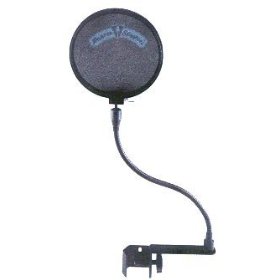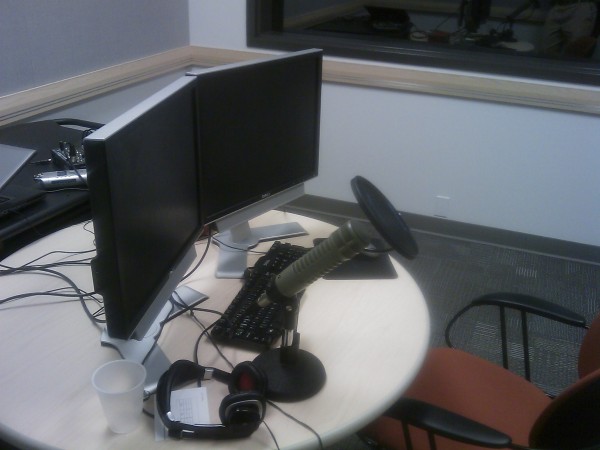Avoiding plosives and breathing noises (Voiceover)
Getting close to your microphone usually results in something called "the proximity effect." As you get close, most microphones amplify your voice in a rich, deep way. The proximity effect can make you sound like a late-night DJ. Some microphones give you the best proximity effect when you're practically kissing the mic.
Unfortunately, as you get closer to a microphone, the microphone starts to pick up more sounds from your mouth. Say the word "pick" or "pull" and you unleash a gust of wind toward the mic. Really, hold your hand up two inches from your mouth and say a few P or B words. Can you feel the gust? To your microphone, the puff is like a tsunami sound wave. This burst of air is known as a plosive.
When you get close, in addition to plosives, microphones also pick up a variety of breathing noises. When you exhale through your nose, the sound can be a low rumble in the microphone. As you finish one sentence and take a breath to start another, that sudden inhalation gets picked up by the microphone. When you open and close your mouth, the sound of your lips separating and smacking finds its way into the microphone.
Here are a few of the sounds I'm talking about. I've used four different mics for comparison.
Shure SM58 (no pop filter)
Shure SM58 (pop filter)
Audix (no pop filter)
Audix (pop filter)
Electro-Voice RE20 (no pop filter)
Electro-Voice RE20 (pop filter)
Radio Shack 33-3042 (no pop filter)
Radio Shack 33-3042 (pop filter)
The easiest way to prevent these plosives and breathing noises from ending up in your recording is through something called a pop filter. You can find a good condenser mic and pop filter online to help give you the most professional sound. The pop filter is essentially pantyhose-like material stretched across a ring and held several inches in front of your microphone. For some reason, the fabric of pantyhose seems to stop plosives. Pantyhose also helps to reduce the various breathing noises I mentioned. In part this is because the pop filter ensures you don't get too close to the mic.

You can make your own pop filter if you're skilled working with wire and have a way to attach it to your microphone. I once tried this but found no way to gracefully attach the coat hanger wire to my microphone outside of gaudy-looking masking tape, which left my mic handle all sticky when I removed the tape.
I have since bought a $38 Shure Popper Stopper and have had felt it to be worthwhile. (Remember that you're not buying a strip of pantyhose for $38. You're buying the mic attachment clip and arm as well as the ring.)
Some pop filters are actually made of metal. I haven't tried a metal pop filter, but I assume they work too. And metal is durable. If you get a nylon (pantyhose) pop filter, make sure you're careful not to tear the nylon. One careless scratch and the nylon gets a run. (I know because when I originally removed my pop filter from the case, I think I scratched it against a package staple and it immediately had a run in the nylon, kind of like this. Luckily for me, the store still exchanged it.)
Here's what the pop filter looks like positioned in front of my microphone.

What about the sacrificed sound that you give up by distancing yourself from the microphone? With a pop filter, you're no longer kissing the mic. If you must get extremely close, you can. The pop filter won't function as well, but you can learn to breathe stealthily, hit pause and resume to take breaths, and edit out your other mouth noises in post-production. You can also just learn to breathe quietly and discreetly. All of this, however, adds to the difficulty of producing a video and extends the post-production time.
For me, the minimization of mouth noises by adding some distance is worth it. I separate my mic from my pop filter with two sideways fingers, and my mouth from the pop filter with the same distance. The sound would be richer if I were closer, but I have to remember that I'm creating a software video tutorial to help someone learn an application, not delivering a late-night thought to sleepless radio listeners. Like your prose, your voice should also be somewhat invisible. Clear, personable, and articulate, but not necessarily a late-night DJ.
The instructions on my Shure pop filter actually say to distance the pop filter between 2 to 8 inches from the mic. I find that different mics record at different levels. When you're 8 inches away from the mic, the sound quality decreases considerably. If you amplify the sound in post-production, static noise from the background also increases.
One downside to the pop filter is that it gets in your way visually. Some people find them so distracting that, instead of using a pop filter, they speak to the right of the mic a bit, so they aren't coming at it head on. Rodney Saulsberry writes,
I think every voice-over actor has a comfort zone in front of the mic, a place where he tends to stand in reference to the mic most of the time. I like to turn my head to the right and work off the right side of the microphone. By working off mic I lessen my chances of popping, which occurs when you blow a burst of air into the mic. The sudden burst causes a sound that generally happens when you use “plosive” words that begin with t, b, or p. Some engineers will put a stocking type device in front of the mic to protect it from plosives. I find this device to be very distracting, which is why I developed my off-mic technique.
As I'm recording a video tutorial, the large diameter of the pop filter does get a little in the way of the computer screen I'm looking at. But I've traded some visibility for the benefits of the pop filter.
About Tom Johnson

I'm an API technical writer based in the Seattle area. On this blog, I write about topics related to technical writing and communication — such as software documentation, API documentation, AI, information architecture, content strategy, writing processes, plain language, tech comm careers, and more. Check out my API documentation course if you're looking for more info about documenting APIs. Or see my posts on AI and AI course section for more on the latest in AI and tech comm.
If you're a technical writer and want to keep on top of the latest trends in the tech comm, be sure to subscribe to email updates below. You can also learn more about me or contact me. Finally, note that the opinions I express on my blog are my own points of view, not that of my employer.
